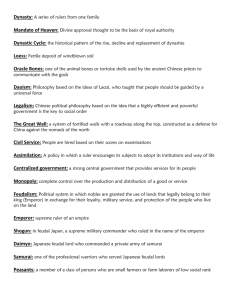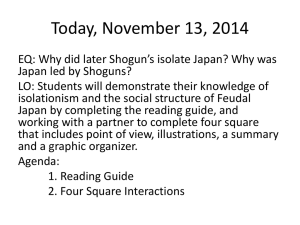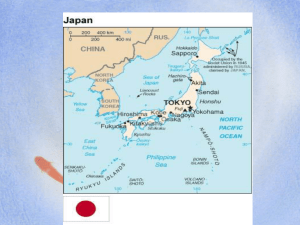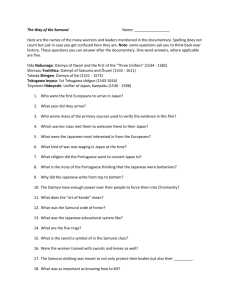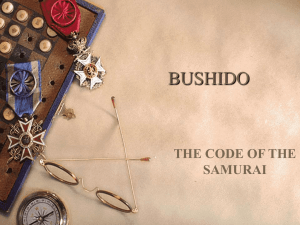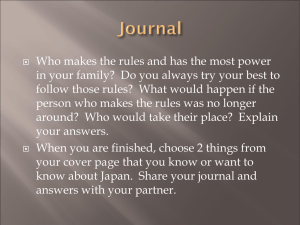Research
advertisement
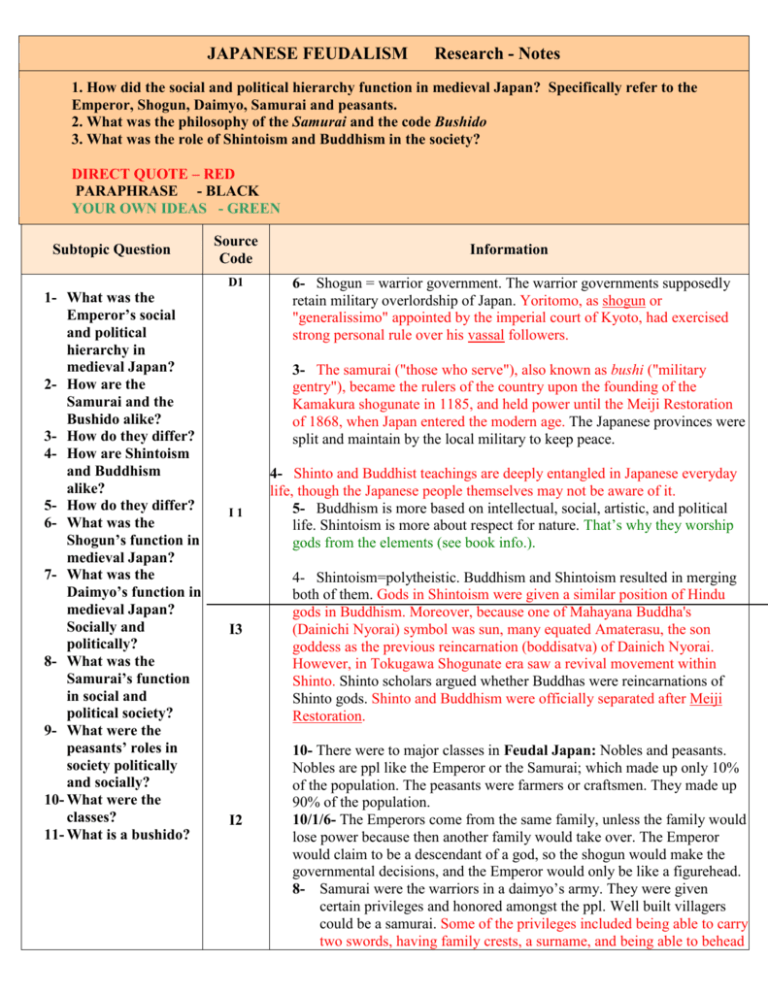
JAPANESE FEUDALISM Research - Notes 1. How did the social and political hierarchy function in medieval Japan? Specifically refer to the Emperor, Shogun, Daimyo, Samurai and peasants. 2. What was the philosophy of the Samurai and the code Bushido 3. What was the role of Shintoism and Buddhism in the society? DIRECT QUOTE – RED PARAPHRASE - BLACK YOUR OWN IDEAS - GREEN Subtopic Question Source Code D1 1- What was the Emperor’s social and political hierarchy in medieval Japan? 2- How are the Samurai and the Bushido alike? 3- How do they differ? 4- How are Shintoism and Buddhism alike? 5- How do they differ? 6- What was the Shogun’s function in medieval Japan? 7- What was the Daimyo’s function in medieval Japan? Socially and politically? 8- What was the Samurai’s function in social and political society? 9- What were the peasants’ roles in society politically and socially? 10- What were the classes? 11- What is a bushido? Information 6- Shogun = warrior government. The warrior governments supposedly retain military overlordship of Japan. Yoritomo, as shogun or "generalissimo" appointed by the imperial court of Kyoto, had exercised strong personal rule over his vassal followers. 3- The samurai ("those who serve"), also known as bushi ("military gentry"), became the rulers of the country upon the founding of the Kamakura shogunate in 1185, and held power until the Meiji Restoration of 1868, when Japan entered the modern age. The Japanese provinces were split and maintain by the local military to keep peace. I1 I3 I2 4- Shinto and Buddhist teachings are deeply entangled in Japanese everyday life, though the Japanese people themselves may not be aware of it. 5- Buddhism is more based on intellectual, social, artistic, and political life. Shintoism is more about respect for nature. That’s why they worship gods from the elements (see book info.). 4- Shintoism=polytheistic. Buddhism and Shintoism resulted in merging both of them. Gods in Shintoism were given a similar position of Hindu gods in Buddhism. Moreover, because one of Mahayana Buddha's (Dainichi Nyorai) symbol was sun, many equated Amaterasu, the son goddess as the previous reincarnation (boddisatva) of Dainich Nyorai. However, in Tokugawa Shogunate era saw a revival movement within Shinto. Shinto scholars argued whether Buddhas were reincarnations of Shinto gods. Shinto and Buddhism were officially separated after Meiji Restoration. 10- There were to major classes in Feudal Japan: Nobles and peasants. Nobles are ppl like the Emperor or the Samurai; which made up only 10% of the population. The peasants were farmers or craftsmen. They made up 90% of the population. 10/1/6- The Emperors come from the same family, unless the family would lose power because then another family would take over. The Emperor would claim to be a descendant of a god, so the shogun would make the governmental decisions, and the Emperor would only be like a figurehead. 8- Samurai were the warriors in a daimyo’s army. They were given certain privileges and honored amongst the ppl. Well built villagers could be a samurai. Some of the privileges included being able to carry two swords, having family crests, a surname, and being able to behead any villagers who did not treat them respectfully. 11- It is the code that a samurai has to follow.(“the way of the warrior”) This meant they had to be loyal and obedient to their master. If the code was broken he would have to follow a suicide ritual called seppuku in which the samurai would disembowel him or herself in a way that was considered honorable and would bring respect back to his/her family once deceased. Women were allowed to be samurai. They had privileges, but could be dominated by a male samurai. However, they still had power over a male in a lower class. 7- There were many clusters of small villages in Japan separated by mountains. The daimyo was the leader of the strongest family in that area. Daimyo means “great name” because they were honored and highly respected. They were like warlords, they had their own army of samurai and people gave the daimyo part of their profits, like a tax. In return, the daimyo would protect the village, repair flood damage, and defend his ppl if there was a war. 6- The shogun was the head of the leading daimyo. They could accept or decline trade agreements, and initiate military attacks. The shogun was the one who made the actual decisions, not the Emperor, although they needed the Emperor’s consent before. They also got a sword like the samurai. Probably ppl who r honored and respected get to carry a sword. 9- The peasants were separated into many classes. The farmers were the highest and the merchants were the lowest. Then the farmers were separated again into the farmers who owned land (higher) and tenant farmers(less important). Since making farms was scarce, food was made valuable making farmers important. They also asked the Shoguns for military help. Craftsmen were 2nd in the rank of peasants. Their work was often made of wood and metal. Merchants were the lowest because they lived off others’ labor. They lived in separate parts of the village and could only consort with people from other classes when doing business. In later times, merchants became wealthier and as money were used for currency instead of rice (and merchants controlled the money), they became more powerful. It got to the point where even poor samurai might adopt a merchant’s son or marry in between families in order to bring money into the family. They were referred to also as 'leeches' because they sucked money and goods off other Japanese groups. 11- The core tenets of Bushido date from as early as the 12th century as demonstrated by the earliest translations of Japanese literature and warrior house codes. Honor codes are still used today in gangs. Under the Tokugawa Shogunate, Bushido became formalized into Japanese Feudal Law. [1] Inazo Nitobe, in his book Bushido: The Soul of Japan, described it in this way. "...Bushido, then, is the code of moral principles which the samurai were required or instructed to observe... More frequently it is a code unuttered and unwritten... It was an organic growth of decades and centuries of military career." The code valued respect, wisdom, honor, glory, benevolence, courage, rectitude, care for the aged, and loyalty; virtues. It’s kind of like Confucianism in China. Confucianism also valued respect, honor and cared for the aged. This is an example of how China and Japan are alike; feudalism. The elders are wiser while the youth respects and takes care of them. One class above the other. I4 4/5- Buddhism separates people into 4 divisions: monks, nuns, laymen, and laywomen, The laity is more “financially” involved in society in the sense that they accumulate wealth, grow crops, distribute it, and maintain order. The simple divisions of Buddhist society are made more complex, however, by the different roles that exist within the monastic com unity; by the complexity of occupations and functions within the lay community and the shifting relationships that bind the two orders of society, monastic and lay, together. The great Indian monasteries became learning centers in secular arts such as literature, medicine, and astrology. Some developed monastic traditions were often linked with royal power. Religion vs. Politics. (God’s role in Politics). Shintoism and Buddhism are the two major religious traditions in Japan. “Shinto” means the way of the gods. Shintoists worship many gods from elements. Research - List of Sources Source Type of Code Source D1 Database Author : Varley, H. Paul MLA citation Title of Article: Ashikaga Takauji Title of Magazine , Newspaper or Encyclopedia: Service Gale Date of publication, volume/issue number: Search strategy Keywords Samurai AND Bushido in History Resource Center World. Title: Samurai Name of Database : Student Research Center Gold URL: http://find.galegroup.com/srcx/ Date of access: Feb 8, 2007 I1 Internet Author : Keywords Title of Article/ Web Page: Religion in Japan Title of Web Site: Wikipedia URL : http://en.wikipedia.org/wiki/Religion_in_Japan Date of publication (or last updated, or copyright): 2/9/07 Date of access: 2/15/07 I2 Internet Author: Title of Article: Feudal Japan hierarchy Title of Web Site: Wikipedia Keywords URL: http://en.wikipedia.org/wiki/Feudal_Japan_hierarchy Date of Publication: 2/10/07 Date of access: 2/15/07 I3 Internet Author: Keywords Title of Article: Buddhism and Eastern Teaching Title of Website: Wikipedia URL: http://en.wikipedia.org/wiki/Buddhism_and_Eastern_teaching Date of publication: 20 November 2006 Date of access: 2/16/07 I4 Internet Author: Keywords Title of Article: Bushido Title of Website: Wikipedia URL: http://en.wikipedia.org/wiki/Bushido Date of publication: 21 Feb 2007 Date of access: 2/23/07 B1 Book Call Number: 291 ILL Author/ Editor: Micheal D. Coogan Keywords: Buddhism Title of book: The Illustrated guide to World Religions City of Publication: New York Publisher: Oxford University Copyright Date: 1998 Volume: Page number: 194 For reference book (encyclopedia) type the Entry (Word you used to find information): B2 Book Call number: 031 WOR Author/Editor: Title of book: World Book City of Publication: Chicago Publisher: World Book Inc Copyright Date: Volume: II Page number: 32-60 For reference book type the Entry: Keywords: Shintoism


